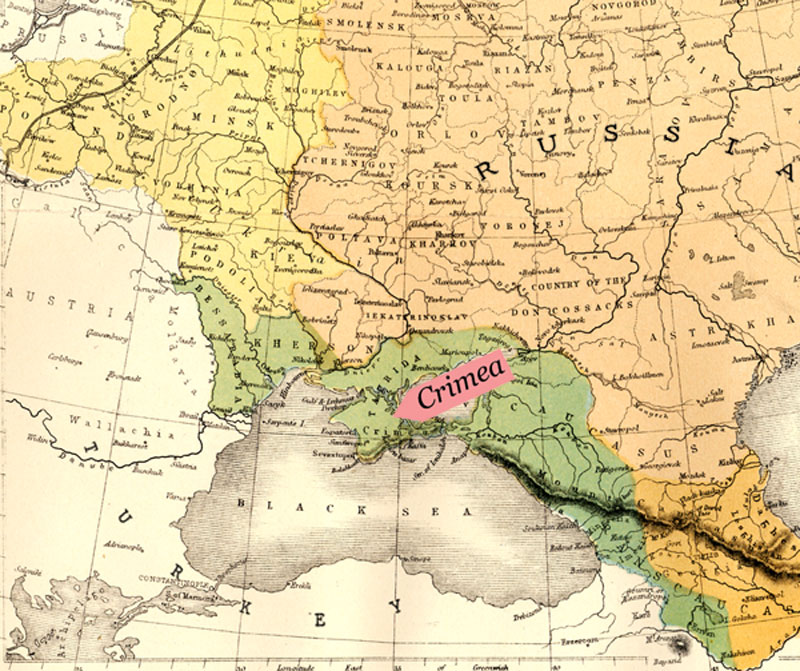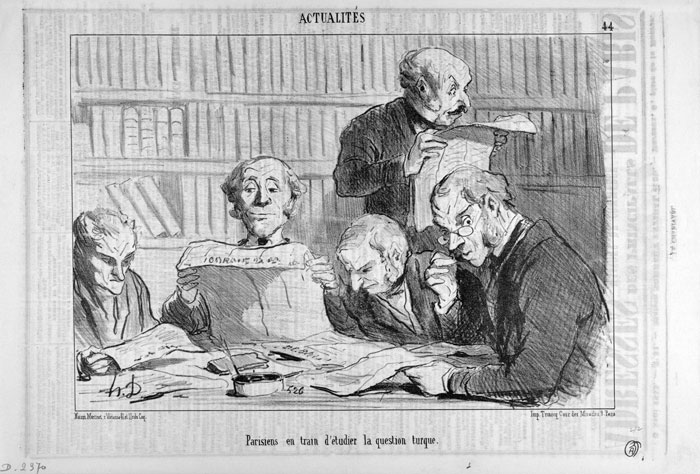The Turkish Question

This map shows the area of conflict during the Crimean War. In crossing the Danube River on the western edge of the Black Sea and into Ottoman territory, the Russians had designs on moving south and taking over Constantinople to open up easy shipping lanes to the Mediterranean. When this plan was thwarted by the Turks, the theater of war shifted to the Crimea, the peninsula that sits at the northern part of the Black Sea.
The Russo-Turkish War and the subsequent Crimean War flared between 1853 and 1856, and together they constituted the largest international conflict involving European powers between the Napoleonic Wars and World War I. Starting in 1851, political tensions ran high between France and Russia over which country should serve as guardian of the Christian Holy Places in Palestine, which at the time fell within the borders of the Ottoman Empire.
After the Turks granted guardianship of the Holy Places to France, Russia reacted by occupying the Danubian Principalities on July 2, 1853 and invading Ottoman territory on March 20, 1854. One week later, Britain and France joined Turkey in declaring war on Russia.
The Turks surprisingly beat the Russians back, pushing them out of Ottoman territory. Russia, however, refused to accept the terms of peace, prompting an invasion of the Crimea by Great Britain and France with the goal of capturing the naval port at Sebastopol and forcing Russia into submission.
July 30, 1853
 Honoré Daumier. Actualités, no. 44. Le Charivari. LD 2370.
Honoré Daumier. Actualités, no. 44. Le Charivari. LD 2370.
“Parisians busy studying the Turkish Question.”
The Russian army crossed the Pruth River on July 3, 1853 and occupied Bucharest by July 15, bringing the Danubian Principalities under Russian control. The French press relentlessly reported on these events and the threat of war.
The Crimean War has been termed the first media war. The development of the telegraph allowed news of the war to be sent home within days rather than weeks. Photography for the first time captured the brutality of war, and these images stirred up considerable outcries among the English and French public. Due to the obscure politics driving the war and the almost immediate reportage of events on the battle fields, popular enthusiasm in support of the war never materialized in England or France.
September 12, 1853
France and England confer while the specter of Russia looms over the sick Sultan of Turkey in anticipation of the break up of the Ottoman Empire.
During the time of the Crimean War, Le Charivari and Punch were the leading satirical publications in France and England, respectively. The French artist Honoré Daumier published many of his famous lithographs in Le Charivari, while John Leech and John Tenniel (the original illustrator of the Alice in Wonderland books) produced almost all of the illustrations for Punch.
These political cartoonists reflected the public' s general ambivalence towards the war by lampooning the botched diplomacy and inept military leadership that led to needless suffering among the soldiers. Most of their satirical invective, however, was aimed at Russia and its role in fomenting war.
